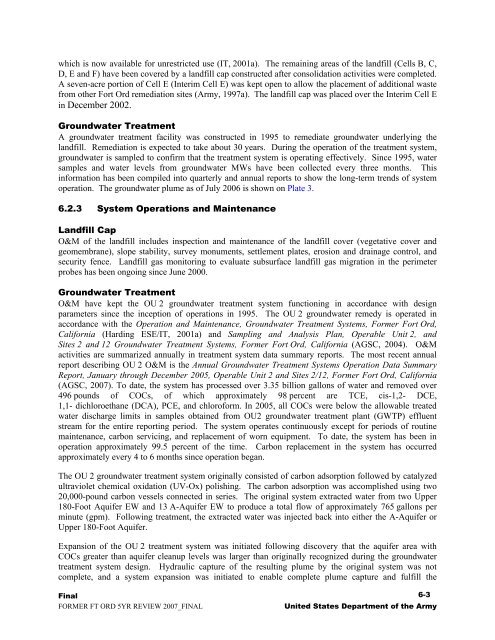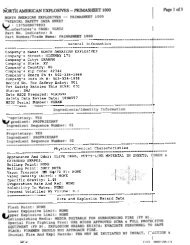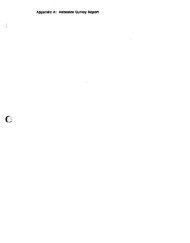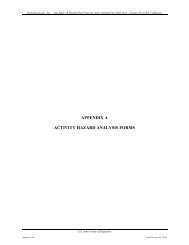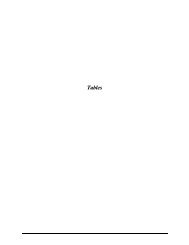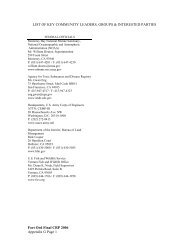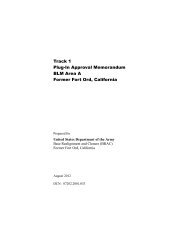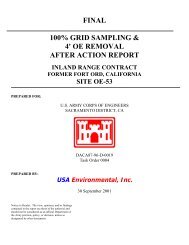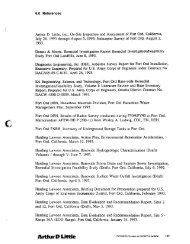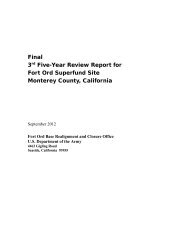Final Second Five-Year Review Report Fort Ord Superfund Site ...
Final Second Five-Year Review Report Fort Ord Superfund Site ...
Final Second Five-Year Review Report Fort Ord Superfund Site ...
You also want an ePaper? Increase the reach of your titles
YUMPU automatically turns print PDFs into web optimized ePapers that Google loves.
which is now available for unrestricted use (IT, 2001a). The remaining areas of the landfill (Cells B, C,<br />
D, E and F) have been covered by a landfill cap constructed after consolidation activities were completed.<br />
A seven-acre portion of Cell E (Interim Cell E) was kept open to allow the placement of additional waste<br />
from other <strong>Fort</strong> <strong>Ord</strong> remediation sites (Army, 1997a). The landfill cap was placed over the Interim Cell E<br />
in December 2002.<br />
Groundwater Treatment<br />
A groundwater treatment facility was constructed in 1995 to remediate groundwater underlying the<br />
landfill. Remediation is expected to take about 30 years. During the operation of the treatment system,<br />
groundwater is sampled to confirm that the treatment system is operating effectively. Since 1995, water<br />
samples and water levels from groundwater MWs have been collected every three months. This<br />
information has been compiled into quarterly and annual reports to show the long-term trends of system<br />
operation. The groundwater plume as of July 2006 is shown on Plate 3.<br />
6.2.3 System Operations and Maintenance<br />
Landfill Cap<br />
O&M of the landfill includes inspection and maintenance of the landfill cover (vegetative cover and<br />
geomembrane), slope stability, survey monuments, settlement plates, erosion and drainage control, and<br />
security fence. Landfill gas monitoring to evaluate subsurface landfill gas migration in the perimeter<br />
probes has been ongoing since June 2000.<br />
Groundwater Treatment<br />
O&M have kept the OU 2 groundwater treatment system functioning in accordance with design<br />
parameters since the inception of operations in 1995. The OU 2 groundwater remedy is operated in<br />
accordance with the Operation and Maintenance, Groundwater Treatment Systems, Former <strong>Fort</strong> <strong>Ord</strong>,<br />
California (Harding ESE/IT, 2001a) and Sampling and Analysis Plan, Operable Unit 2, and<br />
<strong>Site</strong>s 2 and 12 Groundwater Treatment Systems, Former <strong>Fort</strong> <strong>Ord</strong>, California (AGSC, 2004). O&M<br />
activities are summarized annually in treatment system data summary reports. The most recent annual<br />
report describing OU 2 O&M is the Annual Groundwater Treatment Systems Operation Data Summary<br />
<strong>Report</strong>, January through December 2005, Operable Unit 2 and <strong>Site</strong>s 2/12, Former <strong>Fort</strong> <strong>Ord</strong>, California<br />
(AGSC, 2007). To date, the system has processed over 3.35 billion gallons of water and removed over<br />
496 pounds of COCs, of which approximately 98 percent are TCE, cis-1,2- DCE,<br />
1,1- dichloroethane (DCA), PCE, and chloroform. In 2005, all COCs were below the allowable treated<br />
water discharge limits in samples obtained from OU2 groundwater treatment plant (GWTP) effluent<br />
stream for the entire reporting period. The system operates continuously except for periods of routine<br />
maintenance, carbon servicing, and replacement of worn equipment. To date, the system has been in<br />
operation approximately 99.5 percent of the time. Carbon replacement in the system has occurred<br />
approximately every 4 to 6 months since operation began.<br />
The OU 2 groundwater treatment system originally consisted of carbon adsorption followed by catalyzed<br />
ultraviolet chemical oxidation (UV-Ox) polishing. The carbon adsorption was accomplished using two<br />
20,000-pound carbon vessels connected in series. The original system extracted water from two Upper<br />
180-Foot Aquifer EW and 13 A-Aquifer EW to produce a total flow of approximately 765 gallons per<br />
minute (gpm). Following treatment, the extracted water was injected back into either the A-Aquifer or<br />
Upper 180-Foot Aquifer.<br />
Expansion of the OU 2 treatment system was initiated following discovery that the aquifer area with<br />
COCs greater than aquifer cleanup levels was larger than originally recognized during the groundwater<br />
treatment system design. Hydraulic capture of the resulting plume by the original system was not<br />
complete, and a system expansion was initiated to enable complete plume capture and fulfill the<br />
<strong>Final</strong><br />
6-3<br />
FORMER FT ORD 5YR REVIEW 2007_FINAL United States Department of the Army


